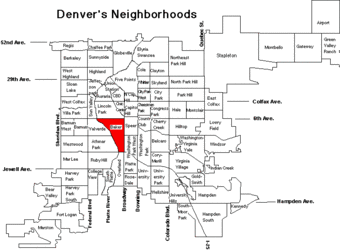Baker, Denver facts for kids
Baker is a cool neighborhood in Denver, Colorado, United States. It's known for its interesting history and mix of old and new buildings. Many people call Baker home, making it a lively and diverse place to live.
Contents
Where is Baker Located?
Baker covers about 955 acres (3.86 km2) of land. It's about 1 mile (1.6 km) south of Denver Civic Center. You can find Baker by looking at these borders:
- North: West 6th Avenue
- East: Broadway
- South: West Mississippi Avenue
- West: The South Platte River
Baker's Historic Areas
What is a Historic District?
A historic district is a special area. It has many old buildings that are important to history. These buildings are protected so they can be saved for the future. Baker has a large historic district. It covers about 150 acres (0.61 km2), which is about 30 city blocks.
Why is Baker's Historic District Special?
The Baker Historic District was officially recognized in 2000. This was part of Denver's plan to save important old places. Many famous people once lived in this area. The buildings show popular architectural styles from 1873 to 1937. Some buildings were even designed by well-known architects.
Most of this same area was added to the National Register of Historic Places in 1985. This is a list of important places across the United States. Long ago, in the 1880s, a bigger area was called "South Side." This name covered a larger part of Denver.
Other Historic Buildings in Baker
Besides the main historic district, Baker has three other special buildings. These are Denver Historic Landmark buildings:
- The Coyle/Chase House at 532 W. 4th Ave. This was the home of Mary Chase, a famous playwright.
- The 1st and Broadway Building at 101-115 N. Broadway.
- Fire Station No. 11 at 40 W. 2nd Ave.
A Look Back: Baker's History
Early Settlers
The land along the river in Baker was first settled in 1859. William and Elizabeth Byers made their home here. Just north of them, James Beckwourth, who was a former slave, also settled that same year.
How Baker Grew
The first part of Baker to be planned for homes was in 1872. It was along Santa Fe Drive. More homes started to be built very quickly in the 1880s. The northern part of Baker became part of Denver in 1883.
Baker has hundreds of brick houses from the 1800s. Many of these were built by 1900. A local architect named William Lang designed 39 buildings here.
How Baker Got Its Name
In the 1970s, the City of Denver named the neighborhood "Baker." It was named after Baker Junior High School. This school is now called the Denver Center for International Studies. The school itself was named after James Hutchins Baker. He was the president of the University of Colorado around 1900. Interestingly, he never actually lived in the Baker neighborhood!
What is Baker Like Today?
A Diverse Community
Baker is a neighborhood with a mix of people. In 2020, over 6,000 people lived there. They come from many different backgrounds. This makes Baker a very diverse and interesting place.
Buildings and Businesses
Baker has a mix of different types of properties:
- Near I-25, you'll find more industrial areas. These are places with factories or workshops.
- Along Broadway, there are many shops and offices.
- The area between Santa Fe and Broadway, north of Alameda, is mostly homes. This is the main residential part of Baker.
South of Alameda Avenue on Broadway, there's a big shopping center. It has several large stores. Further south, there's a former factory complex. This area is planned for a big new development in the future.
Parks and Green Spaces
Baker has several parks where people can relax and play:
- Phil Milstein Park is the biggest park in Baker. It's about 5.48 acres (2.22 hectares).
- Dailey Park is at W. Ellsworth Ave. and S. Cherokee St. It's about 2.66 acres (1.08 hectares).
- Hector M. Flores Park is smaller, about 0.36 acres (0.15 hectares). It's at W. 4th Ave. and N. Galapago St.
- Vanderbilt Park East is about 3.51 acres (1.42 hectares). It's planned to be developed as part of a new project.
Getting Around Baker
It's easy to get around Baker. The neighborhood has several bus lines. It also has two light rail stations:
- Alameda station
- I-25 & Broadway station





